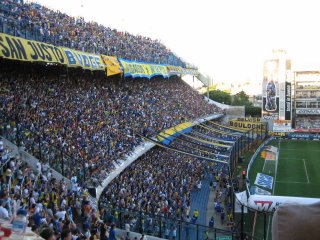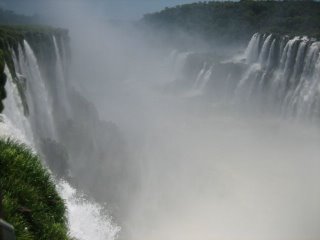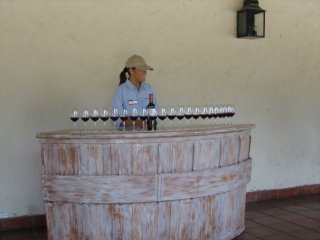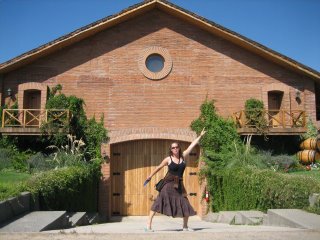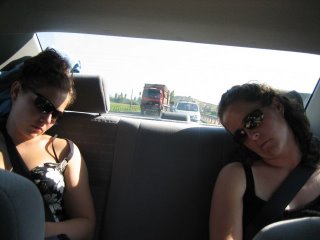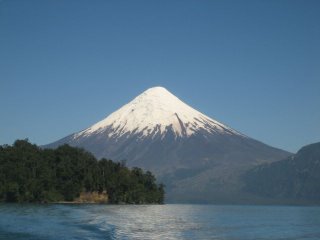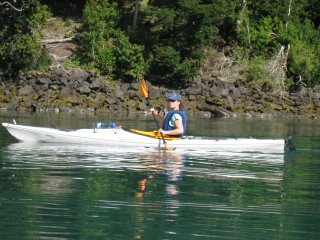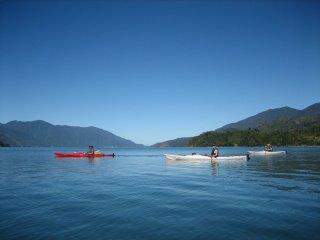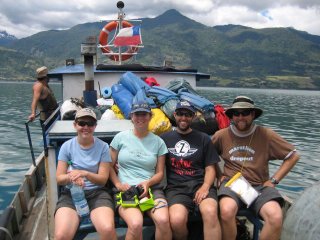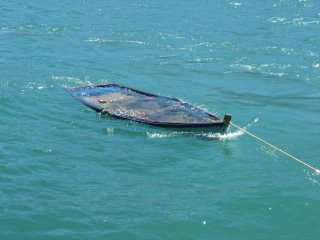Feb 10-12 - The EcoSport Adventure
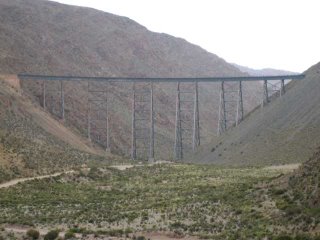 What follows is a slightly shorted version of the email Tanis sent to a few people after we made it back fromm this adventure. Its long. Really long. But since it was already typed up.... This post probably isn't something you want to try to get through in a single sitting.
I think we've just completed the most scary, stressful and exciting excursion of our entire lives. My parents agree. Do you remember the lessons we learned while hiking in Chile and Argentina? That you shouldn't keep hiking on trails where there are no footprints or people and that you should follow the trail markers. Well, the same goes for driving in the Argentina 'outback'. We really got ourselves into a HUGE pickle...
We decided to drive from Salta to Cachi via San Antonio Los Cobres on RN 40 (Ruta Nacional or National Route). The route showed up in the Lonely Planet book and on a couple of the tourist maps. Granted, the tourist maps showed the road as a thin red line and not a big green line like many of the big paved roads. But we didn't let that stop us.
We made it to San Antonio Los Cobres (mainly dirt roads) with no problems. Saw the Viaducto - not the massive engineering feat we expected as described in the Lonely Planet - but we saw it.
Stopped to get gas in San Antonio Los Cobres before heading on to Cachi. San Antonio is a little dirt town, much worse than El Chalten, if you can imagine that. We asked the gas attendant directions to Cachi on RN 40. He told us the way, but didn't warn us about the road, as far as we could tell with our limited Spanish.
We found the road. The road signs said 80km to La Poma - a town half way between San Antonio Los Cobres and Cachi. We were pressed for time as it was already 3:00pm so we hurried along. Passed a few road signs - some really big ones with Spanish words we didn't understand. Some in big red letters. We didn't think to pull the dictionary out to see what they meant, we just kept going. We now think that the sign might have said that the road was no longer being serviced - proceed at your own risk. More or less...
The road kept going up and up. No signs of other vehicles. Maybe a motorbike track and a few bicycle tracks. That didn't stop us though. At some point we started getting into the clouds and had to go pretty slow to keep contact with the road. We kept looking forward to getting to the top. The road was getting narrower and narrower. We figured if we got to the top we'd be home free...
Well when we got to the top - there was a big sign. We had reached 4,895 meters! That's about 15,000 feet. Some planes don't even fly that high! We were quite giddy to say the least. Probably from a lack of oxygen! We've since found out that the mountain pass was the highest point in the Americas that can be traversed by a vehicle. There wasn't any snow, but there was no vegetation and it was quite cold. Particularly as we were up in the clouds! From the Lonely Planet book, the highest peak in the Amerias is the Aconcagua at 6,962m, but you can't reach the top by vehicle.
We were relieved to have reached the top and were happy to start the descent down the other side of the mountain. We were starting to worry about it getting dark and wanted to reach La Poma at least by the end of the day. We considered Cachi unachievable at that point. Understand that the road was not really a road. On the way down we had to often get out to check the road in front us for washouts and move big rocks that had fallen from the mountain bank.
It was a VERY stressful drive down. The Ford EchoSport we had rented from Avis wasn't a 4X4 and definitely wasn't a good vehicle for the terrain. The road got progressively worse. Some wash-outs of the road left us with very little space to get the Ford over. I'm sure there were spots that washed out more behind us as we passed. And it had started to rain. Rain was causing more problems - washing out the road even more. And as we slowly got down in elevation - the rain was creating small rivers that we had to cross. Some as deep as 3 feet. Our stomachs were rolling constantly and everyone was very worried about sliding off the road down the side of the steep mountain. At one point we got a little stuck in a small river. Dad and I had to get behind the Ford in about 3 feet of rushing water and push with all our strength. I believe we lifted the truck out with a combination of brute strength and adrenaline from fear/excitement.
At another point, we crossed over another wash-out and were unlucky enough to pop a tire. We then drove a bit further to a more safe locale and changed the tire as quickly as we could in the cold and rain.
Though we kept our heads and tried to make the best of it. The only sign of human contact had been a little ways down the from the peak. A lone girl with some dogs. No vehicle and no electricity or phone. From what we could understand, she told us it impossible to continue down the road we were going. That the only way out was back up over the peak. But at the time, we knew it was just as impossible for us to get back up the mountain. The little Ford just wouldn't make it.
So we then came to realise that we weren't going to make it to La Poma and that we were going to have to spend the night in the truck and try to hike the remaining 25km down to La Poma for help. We would have to keep going as long as we could to try to make our hike as short as possible.
We decided to stop when we came to yet another water crossing that looked impassable with our little truck. A combination of short wheel base and no 4X4 meant that we had to think really hard about getting the Ford safely across rushing water and boulders. When we decided to stop it was about 8:00pm. It had taken us about 5 hours to travel about 60km. Some of the longest hours of our lives.
But it didn't get any better. We spent the night in the truck. Everyone cramped up. Mom and I in the back and Casey and Dad in the front. Luckily it didn't get too cold. And we had lots of clothes. The only thing we were lacking was water and food. We had eaten breakfast at the hotel in Salta before leaving in the morning. And we had tried to get some lunch in San Antonio Los Cobres at about 1:00 - but the options were very limited. We had purchased some small buns and a small piece of sausage. Once we stopped, we also cut every plastic bottle we had in two and placed then in the bushes next to the Ford in an effort to collect water, which we also had a very short supply of.
Sorry for the long story. But I can't believe what we went through and we'll need this story for posterity!
I'm sure each of us got about 15 minutes of sleep each. Each one of us worrying about how we were going to get to civilisation safely. I worried about my mom with her asthma and altitude sickness. She'd been sick before in Peru. And I worried about my Dad with a bad leg having to walk 25km and possible heart attack. Needless to say, there were some very heart-wrenching words exchanged, each of us trying to give the other some comfort.
It continued to rain most of the night. Each of the small rivers we'd crossed during day had gathered into a larger river that was to our right some 25m away. All night we could hear rocks crashing against rocks as they were propelled down the river with the rushing water. More water wasn't going to help our situation any.
In the morning we got ourselves organized. Took some essentials from our luggage and packed them in our backpacks. Drank 4-5 sips of water each and started hiking down the road.
We discovered about 50m later that we'd stopped for the night near to a few adobe houses with a family or two. Some people live in the most unlikely of places! The woman of the house spoke with us. She suggested that we drive back up the mountain rather than walking down. We told her it was impossible for us to drive back up. We said we had to walk down to La Poma. She then told us that crossing the river was very dangerous because of the moving rocks. So we were very thankful when she suggested that her 13 year old daughter, Nancy, could guide us along the mountain to avoid the river crossings. She took us way up on the side of the mountain on an old goat trail. Along the way, she was also able to point out some clean drinking water. We were glad to have a drink!
After Nancy left us, we had one river crossing we couldn't avoid. And the old woman was right about the rocks in the rushing water. Not necessarily big rocks, just little ones, travelling very fast. We got a nick or two on our feet and Mom has a bit of sore ankle, but nothing really serious.
As we continued down the road, we noticed more and more adobe houses. At one point, we came to one with a tractor. We decided that Casey would stay behind and try to arrange for the tractor to pull our truck through some of the big water crossings. The man of the house was out working in the field and would be returning later for lunch. So Casey would have a bit of a wait. Mom, Dad and I decided to keep on hiking. Hopefully, we'd be able to come upon someone with a car to take us to La Poma where we might be able to arrange for more help.
We hiked along for about an hour, when our salvation came upon us! A big white Defender, containing a family from Buenos Aires. The couple spoke English and they were on summer vacation with their 3 children. They were hoping to travel the mountain pass to San Antonio Los Cobres that afternoon. I was SO thankful to have come upon them. Or them to come to us. Brings a tear to my eye even now.
We told them of our situation and advised them that the road was impassable. They suggested that we go back up the road to see Casey and possibly tow us out with the Defender. So that they could continue up the road rather than giving us a ride back to La Poma. I don't think they realised the severity of the road conditions. Apparently they had checked with the police in La Poma before leaving that morning and had been advised that the road was passable with their vehicle. But as they were are only option, we decided to hop in the back of the Defender and ride along with them. Hoping they would soon discover that they would have to turn around.
We picked Casey up at the farm and made our way to the Ford. Things got a little hairy in one or two spots. But the Defender was able to make the crossings. Once we got to the Ford, I think they realised that we were unlikely to get the Ford down to La Poma, even with their assistance. So we gathered up our luggage, strapped it to the roof of the Defender and made our way back down the mountain.
Along the way, we came across the La Poma police. They were looking for a man on a motor bike that was supposed to be travelling home. His family had reported him missing because he was a day late in returning. We had seen a man on motorbike a couple of hours earlier but we were unable to confirm the man's identity. So they asked if Casey would come along with them to the house of Nancy to help confirm the man's identity. Seemed like an odd request at the time, but we were eager to help in the hopes that the police would reciprocate later by helping us get our vehicle down the mountain.
We waited in the Defender on the road, waiting for Casey to return with the police. It didn't take long and one policeman was knocking on the window of the Defender. They had got the police truck stuck in the river just up the road. So we drove back up to the crossing and pulled the police truck (a small 4X4 Isuzu) out of the river.
As we worked, we noticed another 4X4 Dodge coming down the mountain road above us. They had to have come down the mountain pass that morning after us. The passengers of the Dodge told us that the road above was impassable. That they were lucky to have gotten down that day. So that sealed the deal with the family in the Defender. They wouldn't be attempting the road and would be returning to Salta that night. Similarly, the police decided to close the road as it was now impassable.
We all returned to La Poma. Patricio, the owner of the Defender, helped us sort some help to get the Ford out. The town of La Poma would provide a tractor and a few men to work on the road and pull our Ford out. They quoted 200 pesos, so we jumped on the opportunity. 200 pesos (or $60US) is nothing compared to the possibility of returning no car back to Avis. If the town hadn't volunteered their help, it was likely that the Ford would have to stay where it was until April, when the rivers had dried up and the road could be fixed.
That evening (or last night), Mom, Dad and I travelled back to Salta with Patricio's family. We were so relieved and thankful to get into a bed in a hotel in Salta. Casey had stayed up in La Poma to work with the town's men to rescue the Ford. It seemed best to split up. Mom was having difficulty with her breathing and the facilities in La Poma were very limited. And Casey was in the capable hands of the La Poma police.
About noon today, we were very surprised to get a call from Casey. They had gotten the car out and down to La Poma! It only took them about 4 hours. I couldn't believe it. Though Casey did say that the size of the river had gone down a bit. Which would make things a bit easier. Apparently there is only a scratch on the Ford. Returning the Ford to Avis with only a scratch seems unbelievable.
Casey will have to give a further update on how they rescued the Ford. As of now, he's hopefully driving from La Poma to Salta and we will be hearing the full story from him tonight.
Mom, Dad and I have been trying to relax in Salta. Our muscles our sore from stress and use. I can't believe how tender my shoulders are. Mom's been grinding her teeth and now has a sore jaw. And our stomachs still haven't really settled.
We met up with the Defender family this morning after breakfast and thanked them profusely again for their help. A tear or two was shed - we will surely remember them always. We've got their contact details and will need to send them a personal note and gift, as they wouldn't accept our cash. They return to Buenos Aires on the 22nd, so Casey and I may meet up with them for dinner and to thank them again.
Through-out the day, we've been remembering small bits from the last day or two. We'll likely continue talking about it for sometime. The whole experience has brought us much closer together. And thankful for the small things. Seems like a cliche, but it's true.
We hope to continue to Mendoza (via plane!) tomorrow or the next day. We plan on enjoying the last few days of our vacation. Maybe even splurge on a nice hotel and a massage in a spa!
Again, sorry for the novel. Take a look on the blog in a week or two for a much shorter version with pics!
What follows is a slightly shorted version of the email Tanis sent to a few people after we made it back fromm this adventure. Its long. Really long. But since it was already typed up.... This post probably isn't something you want to try to get through in a single sitting.
I think we've just completed the most scary, stressful and exciting excursion of our entire lives. My parents agree. Do you remember the lessons we learned while hiking in Chile and Argentina? That you shouldn't keep hiking on trails where there are no footprints or people and that you should follow the trail markers. Well, the same goes for driving in the Argentina 'outback'. We really got ourselves into a HUGE pickle...
We decided to drive from Salta to Cachi via San Antonio Los Cobres on RN 40 (Ruta Nacional or National Route). The route showed up in the Lonely Planet book and on a couple of the tourist maps. Granted, the tourist maps showed the road as a thin red line and not a big green line like many of the big paved roads. But we didn't let that stop us.
We made it to San Antonio Los Cobres (mainly dirt roads) with no problems. Saw the Viaducto - not the massive engineering feat we expected as described in the Lonely Planet - but we saw it.
Stopped to get gas in San Antonio Los Cobres before heading on to Cachi. San Antonio is a little dirt town, much worse than El Chalten, if you can imagine that. We asked the gas attendant directions to Cachi on RN 40. He told us the way, but didn't warn us about the road, as far as we could tell with our limited Spanish.
We found the road. The road signs said 80km to La Poma - a town half way between San Antonio Los Cobres and Cachi. We were pressed for time as it was already 3:00pm so we hurried along. Passed a few road signs - some really big ones with Spanish words we didn't understand. Some in big red letters. We didn't think to pull the dictionary out to see what they meant, we just kept going. We now think that the sign might have said that the road was no longer being serviced - proceed at your own risk. More or less...
The road kept going up and up. No signs of other vehicles. Maybe a motorbike track and a few bicycle tracks. That didn't stop us though. At some point we started getting into the clouds and had to go pretty slow to keep contact with the road. We kept looking forward to getting to the top. The road was getting narrower and narrower. We figured if we got to the top we'd be home free...
Well when we got to the top - there was a big sign. We had reached 4,895 meters! That's about 15,000 feet. Some planes don't even fly that high! We were quite giddy to say the least. Probably from a lack of oxygen! We've since found out that the mountain pass was the highest point in the Americas that can be traversed by a vehicle. There wasn't any snow, but there was no vegetation and it was quite cold. Particularly as we were up in the clouds! From the Lonely Planet book, the highest peak in the Amerias is the Aconcagua at 6,962m, but you can't reach the top by vehicle.
We were relieved to have reached the top and were happy to start the descent down the other side of the mountain. We were starting to worry about it getting dark and wanted to reach La Poma at least by the end of the day. We considered Cachi unachievable at that point. Understand that the road was not really a road. On the way down we had to often get out to check the road in front us for washouts and move big rocks that had fallen from the mountain bank.
It was a VERY stressful drive down. The Ford EchoSport we had rented from Avis wasn't a 4X4 and definitely wasn't a good vehicle for the terrain. The road got progressively worse. Some wash-outs of the road left us with very little space to get the Ford over. I'm sure there were spots that washed out more behind us as we passed. And it had started to rain. Rain was causing more problems - washing out the road even more. And as we slowly got down in elevation - the rain was creating small rivers that we had to cross. Some as deep as 3 feet. Our stomachs were rolling constantly and everyone was very worried about sliding off the road down the side of the steep mountain. At one point we got a little stuck in a small river. Dad and I had to get behind the Ford in about 3 feet of rushing water and push with all our strength. I believe we lifted the truck out with a combination of brute strength and adrenaline from fear/excitement.
At another point, we crossed over another wash-out and were unlucky enough to pop a tire. We then drove a bit further to a more safe locale and changed the tire as quickly as we could in the cold and rain.
Though we kept our heads and tried to make the best of it. The only sign of human contact had been a little ways down the from the peak. A lone girl with some dogs. No vehicle and no electricity or phone. From what we could understand, she told us it impossible to continue down the road we were going. That the only way out was back up over the peak. But at the time, we knew it was just as impossible for us to get back up the mountain. The little Ford just wouldn't make it.
So we then came to realise that we weren't going to make it to La Poma and that we were going to have to spend the night in the truck and try to hike the remaining 25km down to La Poma for help. We would have to keep going as long as we could to try to make our hike as short as possible.
We decided to stop when we came to yet another water crossing that looked impassable with our little truck. A combination of short wheel base and no 4X4 meant that we had to think really hard about getting the Ford safely across rushing water and boulders. When we decided to stop it was about 8:00pm. It had taken us about 5 hours to travel about 60km. Some of the longest hours of our lives.
But it didn't get any better. We spent the night in the truck. Everyone cramped up. Mom and I in the back and Casey and Dad in the front. Luckily it didn't get too cold. And we had lots of clothes. The only thing we were lacking was water and food. We had eaten breakfast at the hotel in Salta before leaving in the morning. And we had tried to get some lunch in San Antonio Los Cobres at about 1:00 - but the options were very limited. We had purchased some small buns and a small piece of sausage. Once we stopped, we also cut every plastic bottle we had in two and placed then in the bushes next to the Ford in an effort to collect water, which we also had a very short supply of.
Sorry for the long story. But I can't believe what we went through and we'll need this story for posterity!
I'm sure each of us got about 15 minutes of sleep each. Each one of us worrying about how we were going to get to civilisation safely. I worried about my mom with her asthma and altitude sickness. She'd been sick before in Peru. And I worried about my Dad with a bad leg having to walk 25km and possible heart attack. Needless to say, there were some very heart-wrenching words exchanged, each of us trying to give the other some comfort.
It continued to rain most of the night. Each of the small rivers we'd crossed during day had gathered into a larger river that was to our right some 25m away. All night we could hear rocks crashing against rocks as they were propelled down the river with the rushing water. More water wasn't going to help our situation any.
In the morning we got ourselves organized. Took some essentials from our luggage and packed them in our backpacks. Drank 4-5 sips of water each and started hiking down the road.
We discovered about 50m later that we'd stopped for the night near to a few adobe houses with a family or two. Some people live in the most unlikely of places! The woman of the house spoke with us. She suggested that we drive back up the mountain rather than walking down. We told her it was impossible for us to drive back up. We said we had to walk down to La Poma. She then told us that crossing the river was very dangerous because of the moving rocks. So we were very thankful when she suggested that her 13 year old daughter, Nancy, could guide us along the mountain to avoid the river crossings. She took us way up on the side of the mountain on an old goat trail. Along the way, she was also able to point out some clean drinking water. We were glad to have a drink!
After Nancy left us, we had one river crossing we couldn't avoid. And the old woman was right about the rocks in the rushing water. Not necessarily big rocks, just little ones, travelling very fast. We got a nick or two on our feet and Mom has a bit of sore ankle, but nothing really serious.
As we continued down the road, we noticed more and more adobe houses. At one point, we came to one with a tractor. We decided that Casey would stay behind and try to arrange for the tractor to pull our truck through some of the big water crossings. The man of the house was out working in the field and would be returning later for lunch. So Casey would have a bit of a wait. Mom, Dad and I decided to keep on hiking. Hopefully, we'd be able to come upon someone with a car to take us to La Poma where we might be able to arrange for more help.
We hiked along for about an hour, when our salvation came upon us! A big white Defender, containing a family from Buenos Aires. The couple spoke English and they were on summer vacation with their 3 children. They were hoping to travel the mountain pass to San Antonio Los Cobres that afternoon. I was SO thankful to have come upon them. Or them to come to us. Brings a tear to my eye even now.
We told them of our situation and advised them that the road was impassable. They suggested that we go back up the road to see Casey and possibly tow us out with the Defender. So that they could continue up the road rather than giving us a ride back to La Poma. I don't think they realised the severity of the road conditions. Apparently they had checked with the police in La Poma before leaving that morning and had been advised that the road was passable with their vehicle. But as they were are only option, we decided to hop in the back of the Defender and ride along with them. Hoping they would soon discover that they would have to turn around.
We picked Casey up at the farm and made our way to the Ford. Things got a little hairy in one or two spots. But the Defender was able to make the crossings. Once we got to the Ford, I think they realised that we were unlikely to get the Ford down to La Poma, even with their assistance. So we gathered up our luggage, strapped it to the roof of the Defender and made our way back down the mountain.
Along the way, we came across the La Poma police. They were looking for a man on a motor bike that was supposed to be travelling home. His family had reported him missing because he was a day late in returning. We had seen a man on motorbike a couple of hours earlier but we were unable to confirm the man's identity. So they asked if Casey would come along with them to the house of Nancy to help confirm the man's identity. Seemed like an odd request at the time, but we were eager to help in the hopes that the police would reciprocate later by helping us get our vehicle down the mountain.
We waited in the Defender on the road, waiting for Casey to return with the police. It didn't take long and one policeman was knocking on the window of the Defender. They had got the police truck stuck in the river just up the road. So we drove back up to the crossing and pulled the police truck (a small 4X4 Isuzu) out of the river.
As we worked, we noticed another 4X4 Dodge coming down the mountain road above us. They had to have come down the mountain pass that morning after us. The passengers of the Dodge told us that the road above was impassable. That they were lucky to have gotten down that day. So that sealed the deal with the family in the Defender. They wouldn't be attempting the road and would be returning to Salta that night. Similarly, the police decided to close the road as it was now impassable.
We all returned to La Poma. Patricio, the owner of the Defender, helped us sort some help to get the Ford out. The town of La Poma would provide a tractor and a few men to work on the road and pull our Ford out. They quoted 200 pesos, so we jumped on the opportunity. 200 pesos (or $60US) is nothing compared to the possibility of returning no car back to Avis. If the town hadn't volunteered their help, it was likely that the Ford would have to stay where it was until April, when the rivers had dried up and the road could be fixed.
That evening (or last night), Mom, Dad and I travelled back to Salta with Patricio's family. We were so relieved and thankful to get into a bed in a hotel in Salta. Casey had stayed up in La Poma to work with the town's men to rescue the Ford. It seemed best to split up. Mom was having difficulty with her breathing and the facilities in La Poma were very limited. And Casey was in the capable hands of the La Poma police.
About noon today, we were very surprised to get a call from Casey. They had gotten the car out and down to La Poma! It only took them about 4 hours. I couldn't believe it. Though Casey did say that the size of the river had gone down a bit. Which would make things a bit easier. Apparently there is only a scratch on the Ford. Returning the Ford to Avis with only a scratch seems unbelievable.
Casey will have to give a further update on how they rescued the Ford. As of now, he's hopefully driving from La Poma to Salta and we will be hearing the full story from him tonight.
Mom, Dad and I have been trying to relax in Salta. Our muscles our sore from stress and use. I can't believe how tender my shoulders are. Mom's been grinding her teeth and now has a sore jaw. And our stomachs still haven't really settled.
We met up with the Defender family this morning after breakfast and thanked them profusely again for their help. A tear or two was shed - we will surely remember them always. We've got their contact details and will need to send them a personal note and gift, as they wouldn't accept our cash. They return to Buenos Aires on the 22nd, so Casey and I may meet up with them for dinner and to thank them again.
Through-out the day, we've been remembering small bits from the last day or two. We'll likely continue talking about it for sometime. The whole experience has brought us much closer together. And thankful for the small things. Seems like a cliche, but it's true.
We hope to continue to Mendoza (via plane!) tomorrow or the next day. We plan on enjoying the last few days of our vacation. Maybe even splurge on a nice hotel and a massage in a spa!
Again, sorry for the novel. Take a look on the blog in a week or two for a much shorter version with pics!
